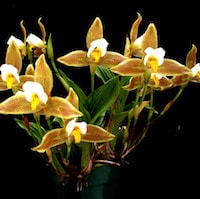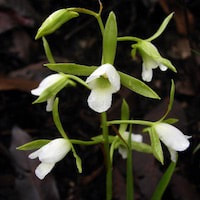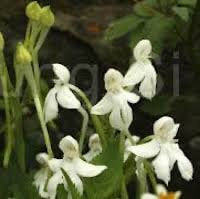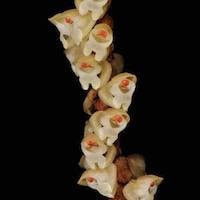Elevate Your Well-being with Orchid Aromatherapy
Scentopia's Orchid Fragrance is a meticulously crafted blend of scented notes, carefully incorporating various orchid species in different proportions. Among the key components are the Native Singaporean Orchid (Lycaste Deppei), known for its growth on trees and rocks in humid forests. This small to medium-sized epiphyte blooms in the spring, emitting a fragrance characterized by hints of peppermint or soft eucalyptus, with some perceiving undertones of root-beer or antiseptic.
The Therapeutic Orchid (Eulophia herbacea Lindl.) is a terrestrial orchid found in lowland areas across Indochina, Thailand, Bangladesh, and India. Its tubers are utilized as a tonic and blood purifier, while the pseudobulbs are employed to address insect bites in Thailand.
Habenaria longicorniculata J Graham Syn. Habenaria longecalcarata A. Rich. is another significant component of the fragrance. This orchid species flowers in the Western Ghats from July to September and in Tamil Nadu from August to November. With an elevation range of 800-1900 meters, various parts of the plant, including the tubers, are used to manage pain and swelling. A mixture of crushed tuber and turmeric powder is applied to treat leukoderma.
Pholidota pallida Lindl., distributed across Nepal, Bhutan, northeast India, Yunnan, Myanmar, Thailand, Laos, and Vietnam, thrives in forested areas at specific elevations. The root and pseudobulb of this orchid are employed in herbal applications to alleviate fever, induce sleep, and relieve abdominal pain.
Alongside the orchid notes, Scentopia's Orchid Fragrance incorporates a touch of lily of the valley, fresh hyacinth, and wisteria. These additional scent notes contribute to the overall complexity of the fragrance.
The blending process behind Scentopia's Orchid Fragrance harmonizes the scented notes of these orchid species, resulting in a captivating and diverse olfactory experience that showcases the beauty and allure of orchids.
The Therapeutic Orchid (Eulophia herbacea Lindl.) is a terrestrial orchid found in lowland areas across Indochina, Thailand, Bangladesh, and India. Its tubers are utilized as a tonic and blood purifier, while the pseudobulbs are employed to address insect bites in Thailand.
Habenaria longicorniculata J Graham Syn. Habenaria longecalcarata A. Rich. is another significant component of the fragrance. This orchid species flowers in the Western Ghats from July to September and in Tamil Nadu from August to November. With an elevation range of 800-1900 meters, various parts of the plant, including the tubers, are used to manage pain and swelling. A mixture of crushed tuber and turmeric powder is applied to treat leukoderma.
Pholidota pallida Lindl., distributed across Nepal, Bhutan, northeast India, Yunnan, Myanmar, Thailand, Laos, and Vietnam, thrives in forested areas at specific elevations. The root and pseudobulb of this orchid are employed in herbal applications to alleviate fever, induce sleep, and relieve abdominal pain.
Alongside the orchid notes, Scentopia's Orchid Fragrance incorporates a touch of lily of the valley, fresh hyacinth, and wisteria. These additional scent notes contribute to the overall complexity of the fragrance.
The blending process behind Scentopia's Orchid Fragrance harmonizes the scented notes of these orchid species, resulting in a captivating and diverse olfactory experience that showcases the beauty and allure of orchids.
Download the guided mediation that works best with this Orchid fragrance oil
| men_fresh_essential_oil_orchi_00007.mp3 | |
| File Size: | 120923 kb |
| File Type: | mp3 |
Therapeutic Blends for Men
Contains Scented Notes of following in various proportions:
Native Singaporean Orchid notes: Lycaste Deppei
|
Lycaste Deppei - Used in Fresh 7 (Men) for Team building Perfume workshop
The orchid known as Lycaste Deppei is a fascinating species that thrives on trees and rocks within humid forests. It is a small to medium-sized epiphyte with a preference for cold to warm climates. The plant is characterized by several apical, elliptic-lanceolate, plicate leaves that are deciduous and acuminate. When these leaves fall, they leave behind a few sharp spines. One of the most remarkable features of Lycaste Deppei is its very fragrant flowers, which bloom in the spring. These flowers are arranged erectly and appear in multiple clusters simultaneously, creating a captivating display. When encountering the scent of Lycaste Deppei, some individuals perceive hints of peppermint or soft eucalyptus. Interestingly, within a group, there are varying interpretations of its aroma, with some perceiving notes reminiscent of root-beer, while others associate it with antiseptic qualities. These diverse scent perceptions contribute to the intriguing allure of the fragrance. The Lycaste Deppei orchid, with its aromatic presence and unique scent profile, adds a distinctive character to Scentopia's Orchid Fragrance, enhancing its overall olfactory experience. |
Therapeutic Orchid notes:
|
Eulophia herbacea Lindl.
Chinese name: Maochun Meiguan Lan Thai Name: Wan Mangmum Known as Wan Mangmum in Thai, this orchid species is a terrestrial and herbaceous plant. It can be found in lowland areas across Indochina, Thailand, Bangladesh, and throughout India. In traditional herbal practices, the tubers of this orchid are sold in Indian bazaars under the name "salep misri." They are believed to possess tonic properties and are utilized as a blood purifier. It is believed that illnesses caused by impurities in the blood can be addressed through the use of this orchid. In Thailand, the pseudobulbs of the orchid are used specifically for treating insect bites. The Wan Mangmum orchid holds a significant place in traditional medicine, where its tubers are valued for their potential therapeutic benefits. By utilizing this orchid, individuals seek to improve overall well-being by promoting blood purification and addressing specific ailments believed to stem from impurities in the blood. Additionally, the orchid's pseudobulbs offer relief from insect bites, further highlighting its practical applications in traditional medicine. |
|
Habenaria longicorniculata J Graham Syn. Habenaria longecalcarata A. Rich.
Indian name: Devasunda. Tamil name: Kozhikilangu Japanese name: Oze-no-sawa-tombo This orchid species is known by various names in different regions: Devasunda in India, Kozhikilangu in Tamil, and Oze-no-sawa-tombo in Japanese. It blooms from July to September in the Western Ghats and from August to November in Tamil Nadu. The orchid is typically found at elevations ranging from 800 to 1900 meters, with its distribution extending to Orissa and Bihar in the northeast of India. In traditional herbal practices, folk practitioners known as Natti Vaidyas have reported the consumption of fresh tubers to reduce scrotal enlargement. Furthermore, all parts of the plant are utilized to alleviate pain and swelling. A paste is made by crushing the tuber and mixing it with an equal volume of turmeric powder. This colored paste is then applied to the affected area to address leukoderma, a condition characterized by the loss of skin pigmentation. The herbal usage of this orchid species, known by different names in different cultures, highlights its therapeutic potential. Its fresh tubers are consumed for specific concerns, while various parts of the plant are employed to manage pain, swelling, and skin conditions. The traditional knowledge surrounding this orchid contributes to the repertoire of remedies used by folk practitioners to address specific health issues. |
|
Pholidota pallida Lindl.
Chinese name: Eumaishixiantao The orchid known as Eumaishixiantao has its distribution ranging from central Nepal, Bhutan, and northeast India to south and southwest Yunnan in China, as well as Myanmar, Thailand, Laos, and Vietnam. It thrives in forests at altitudes ranging from 800 to 2700 meters in Yunnan and 500 to 2000 meters in Nepal. In traditional herbal practices, this orchid species is utilized for its therapeutic properties. The paste derived from its root and pseudobulb is used to alleviate fever, while the powder is employed to induce sleep and relieve abdominal pain. Additionally, the juice derived from Eumaishixiantao is specifically used to address abdominal pain centered around the navel. The utilization of this orchid in traditional medicine showcases its potential for medicinal applications. The paste, powder, and juice derived from various parts of Eumaishixiantao are harnessed to alleviate specific symptoms, offering relief from fever, sleeplessness, and abdominal discomfort. The traditional knowledge surrounding this orchid contributes to its value in herbal practices. |
Other scent note
Scentopia Library Reference ingredient
Celery - Check details at Scentopia's scent library
Join Scentopia's wonderful orchid scent crafting, fragrance tour, bridal shower or corporate team building which includes perfume making onsite and offsite, beach activities and more. We also serve primary school learning journey, secondary students and pupil on industrial excursions. Know more about our orchids perfume bar or therapeutic orchid scents and other wellness aromas. Conatct Perfume workshop or book a scent crafting session here.



